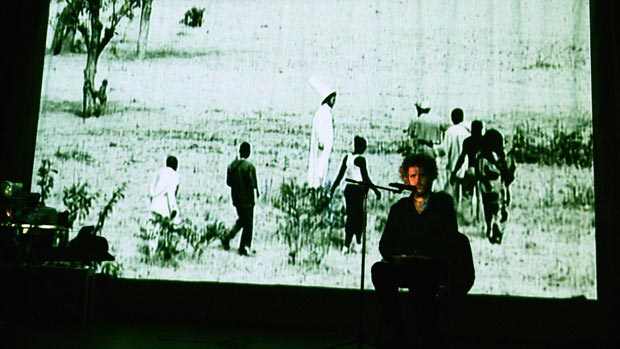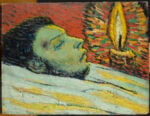Christoph Schlingensief

Il progetto di Christoph Schlingensief rappresenterà la Germania alla Biennale di Venezia.
Comunicato stampa
Plan B:
Pavilion of Germany at the 54th International Art Exhibition – la Biennale di Venezia in 2011 will present Christoph Schlingensief.
You can get a glimpse of the exhibition at the Pavilion of Germany 2011 on our website www.deutsche-pavillon.org.
Press release, October 20, 2010
“...ultimately, what counts is that I feel safe knowing that there is a social thrust to my work”
(Christoph Schlingensief)
Dr. Susanne Gaensheimer, Commissioner of Pavilion of Germany of the 54th International Art Exhibition – la Biennale di Venezia in 2011 and Director of MMK Museum für Moderne Kunst Frankfurt/Main, has announced that the work of Christoph Schlingensief will be presented in Venice despite his untimely death.
“When inviting Christoph Schlingensief in May of this year I explained that my basic idea was to approach an artist of my generation, who has worked for a significant time (which in the case of Christoph Schlingensief was almost 30 years) and in a significant way, someone who not only witnessed the artistic, social and political issues of the two decades of post-reunification Germany, but also took an active role in defining them. Christoph Schlingensief was one of the most important artists in this country, one who never shied away from voicing his opinion and maintaining his position, wholeheartedly, even towards himself, with the utmost clarity and directness, such as is necessary if you want to comment on conditions effectively. Christoph Schlingensief‟s tragic death has in no way affected my conviction that the decision to invite him was the right one,” Dr. Susanne Gaensheimer concludes.
From the early 1980s onwards, Christoph Schlingensief explored a variety of different media in his work. He made films, was involved in political action, theater, art projects, and opera. Even though he originally decidedly left behind the legacy of what was known as Neuer Deutscher Film (new German film), on many levels we can compare his work to that of Rainer Werner Fassbinder. In particularly, this is true as regards team work, an approach that, though common in the world of film and theater, still tends to be the exception in the visual arts, and yet influenced his work for decades. The fact that Schlingensief immersed himself in such a variety of different media and genres makes it impossible to pigeonhole him. Indeed, a key aspect of his work consists of transgressing and dissolving genre-specific boundary lines and the alleged clarity of form and content. Schlingensief‟s oeuvre is extremely complex and it is in the nature of his work that it finds itself in a permanent state of self-exploration and change. Schlingensief used language as the fundamental starting point for his work, across the board.
As there are no translations, subtitles or English versions of his work, the Pavilion of Germany will not only to present Schlingensief‟s work, but will also make it accessible to an international audience.
Christoph Schlingensief had a multitude of ideas and thoughts during the intense collaborative effort committed to his project for the Pavilion of Germany, and some of those ideas were already very detailed. Nonetheless, Susanne Gaensheimer had decided not to use them: “It is impossible to realize a Christoph Schlingensief project without Christoph Schlingensief. Almost a year before the Biennial was due to open a number of questions were of course not yet answered, and anyone who ever experienced Schlingensief‟s way of working will tell you that up until opening day there would have been countless changes. No one will ever be able to replace him, and without him it will be impossible to see his ideas through to the end. That said, we will document his plans and ideas using a variety of different media.”
The pavilion itself will feature works and projects by Christoph Schlingensief that were central to his oeuvre and fundamentally influenced the shape his ideas for the 2011 Pavilion of Germany took. During the next month of this year a website will go online publishing this process. The ideas that Christoph Schlingensief developed for the pavilion will be published in a book to coincide with the preview of the Biennial on June 1st, 2011.
“My decision to invite Christoph Schlingensief to Venice was ultimately also influenced by his Africa project, namely the opera village in Ouagadougou,” Susanne Gaensheimer commented in June 2010. “What becomes clear here is that Schlingensief is not only representative of art in Germany, but that he puts his concerns in a global context. Planning the opera house in Africa and cooperating with the local partners there – first and foremost Francis Kéré, the architect of the opera village who received the Aga-Khan Prize – and, importantly, by using the project for self-reflection and dealing with his own failure in his current play Via Intolleranza II, Schlingensief succeeds in giving his analysis of „being German‟ and the issues associated there with a transnational dimension: „Why are we always so interested in helping the African continent if we can‟t even help ourselves?‟ he asks. The opera village
will take center stage in our work on next year‟s Pavilion of Germany,” Gaensheimer commented today.
In early May 2010, Christoph Schlingensief himself commented on his invitation in the following words: “I have worked in many different fields, as a director in film, theater and opera, producer, solo entertainer, human being, also as a sick human being and Christian, and equally so as a politician and performer, and I have always taken an interest in those artists who felt almost compelled to practice their art, and in so doing did not necessarily separate their compulsion from that of having or wanting to live. A kind of schizophrenia has always been typical of my work and my life. If I limited myself to one thing only I would simply get bored, my mind would be starved of inspiration. Between music and image, people and language, the healthy and the infirm, the funny and the sad I always need to be given the chance to state the opposite too. To my mind, everything in the world is ambiguous. The task of using the Pavilion of Germany, which very much looks like a representative building, not for the purpose of representation but for art, simply fits the bill – a heavy burden, yet art makes light what would otherwise be heavy. And yet perhaps it is precisely what makes it so positive. I, for my part, love those cracks and opposites, and over the coming months I intend to seek out the most productive opposites for Venice, the Pavilion of Germany, and Burkina Faso.”
The exhibition in the Pavilion of Germany has been commissioned by the Federal Foreign Ministry and is realized in cooperation with Institut für Auslandsbeziehungen (ifa/ Institute for Foreign Cultural Relations).
The Publishing house Kiepenheuer & Witsch, who published in 2009 So schön wie hier kanns im Himmel gar nicht sein! Tagebuch einer Krebserkrankung by Christoph Schlingensief, will bring out the publication for the German Pavilion 2011. The book is a collection of raughly 40 contributions by authors such as Diedrich Diederichsen to Charlotte Roche, Jonathan Meese and Alexander Kluge, Carl Hegemann and Boris Groys.The english edition will be released at the Publishing house Sternberg-Press. ISBN 978-1-934105-42-9, ca. 265 pages, softcover, €29.00



